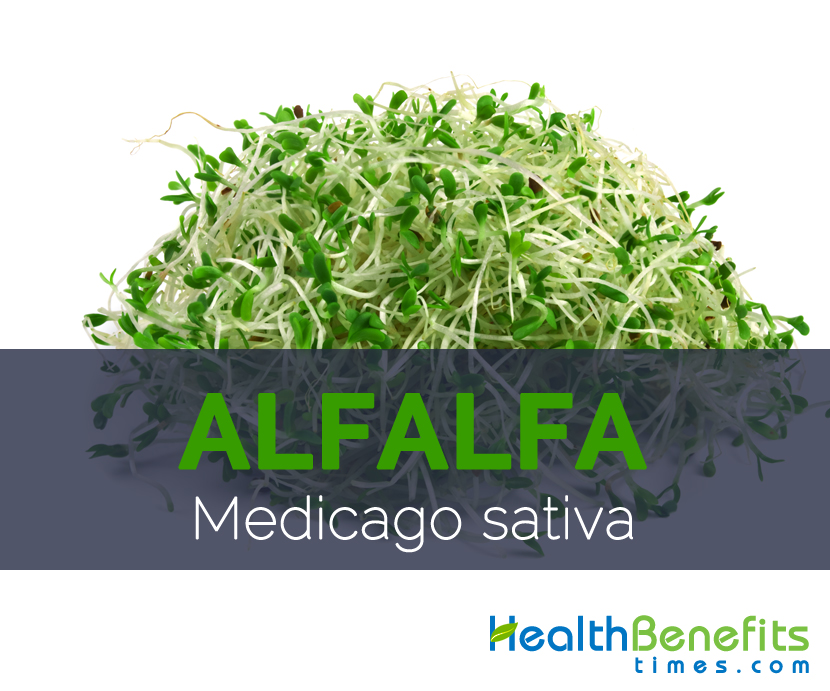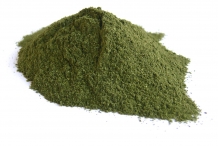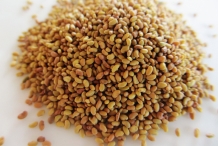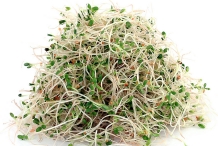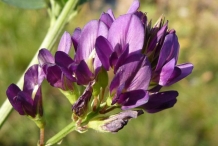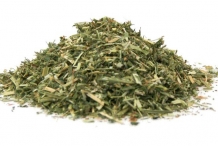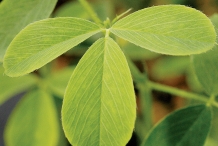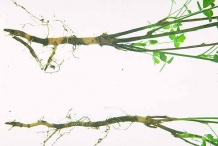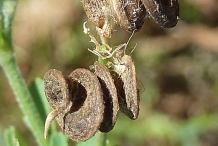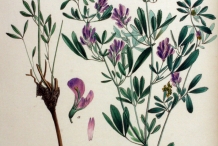| Alfalfa Quick Facts | ||
|---|---|---|
| Name: | Alfalfa | |
| Scientific Name: | Medicago sativa | |
| Origin | South-central Asia, first cultivated in ancient Iran | |
| Colors | Yellow, castaneous or brown | |
| Shapes | Ovoid, irregularly cordate or reniform | |
| Taste | Slightly bland | |
| Calories | 23 Kcal./cup | |
| Major nutrients | Vitamin K (25.42%) Copper(17.44%) Iron (12.00%) Vitamin B5 (11.26%) Phosphorus (10.00%) |
|
| Health benefits | Builds Stamina, Muscle Function, Bursitis and Muscle Problems,Diabetes, Cardiovascular disease, Arthritis, Blood Clotting | |
| Proximity | Amount | % DV |
|---|---|---|
| Water | 92.82 g | N/D |
| Energy | 23 Kcal | N/D |
| Energy | 96 kJ | N/D |
| Protein | 3.99 g | 7.98% |
| Total Fat (lipid) | 0.69 g | 1.97% |
| Ash | 0.4 g | N/D |
| Carbohydrate | 2.1 g | 1.62% |
| Total dietary Fiber | 1.9 g | 5.00% |
| Total Sugars | 0.2 g | N/D |
| Glucose (dextrose) | 0.08 g | N/D |
| Fructose | 0.12 g | N/D |
| Minerals | Amount | % DV |
|---|---|---|
| Copper, Cu | 0.157 mg | 17.44% |
| Iron, Fe | 0.96 mg | 12.00% |
| Phosphorus, P | 70 mg | 10.00% |
| Zinc, Zn | 0.92 mg | 8.36% |
| Manganese, Mn | 0.188 mg | 8.17% |
| Magnesium, Mg | 27 mg | 6.43% |
| Calcium, Ca | 32 mg | 3.20% |
| Potassium, K | 79 mg | 1.68% |
| Selenium, Se | 0.6 µg | 1.09% |
| Sodium, Na | 6 mg | 0.40% |
| Vitamins | Amount | % DV |
|---|---|---|
| Vitamin K (phylloquinone) | 30.5 µg | 25.42% |
| Vitamin B5 (Pantothenic acid) | 0.563 mg | 11.26% |
| Vitamin B2 (Riboflavin) | 0.126 mg | 9.69% |
| Vitamin C (Ascorbic acid) | 8.2 mg | 9.11% |
| Vitamin B9 (Folate, Folic acid) | 36 µg | 9.00% |
| Vitamin B1 (Thiamin) | 0.076 mg | 6.33% |
| Vitamin B3 (Niacin) | 0.481 mg | 3.01% |
| Choline | 14.4 mg | 2.62% |
| Vitamin B6 (Pyridoxine) | 0.034 mg | 2.62% |
| Vitamin A | 8 µg | 1.14% |
| Vitamin E (alpha-tocopherol) | 0.02 mg | 0.13% |
| Beta Carotene | 87 µg | N/D |
| alpha Carotene | 6 µg | N/D |
| Beta Cryptoxanthin | 6 µg | N/D |
| Betaine | 0.4 mg | N/D |
| Lipids | Amount | % DV |
|---|---|---|
| Fatty acids, total saturated | 0.069 g | 0.11% |
| Myristic acid 14:00(Tetradecanoic acid) | 0.002 g | N/D |
| Palmitic acid 16:00 (Hexadecanoic acid) | 0.059 g | N/D |
| Stearic acid 18:00 (Octadecanoic acid) | 0.008 g | N/D |
| Fatty acids, total monounsaturated | ||
| Oleic acid 18:1 (octadecenoic acid) | 0.056 g | N/D |
| Fatty acids, total polyunsaturated | 0.409 g | 2.41% |
| Linoleic acid 18:2 (octadecadienoic acid) | 0.234 g | N/D |
| Linolenic acid 18:3 (Octadecatrienoic acid) | 0.175 g | N/D |
| Amino Acids | Amount | % DV |
|---|---|---|
| Isoleucine | 0.143 g | 8.55% |
| Threonine | 0.134 g | 7.61% |
| Leucine | 0.267 g | 7.22% |
| Valine | 0.145 g | 6.87% |
| Lysine | 0.214 g | 6.40% |
| Flavonols | Amount | % DV |
|---|---|---|
| Quercetin | 1.7 mg | N/D |
| Isoflavones | ||
| Daidzein | 0.02 mg | N/D |
| Genistein | 0.02 mg | N/D |
| Total isoflavones | 0.04 mg | N/D |
| Biochanin A | 0.03 mg | N/D |
| Formononetin | 1.43 mg | N/D |
| Coumestrol | 1.6 mg | N/D |
Health benefits of Alfalfa
1. Cardiovascular disease
Scientific research done to test the effects of alfalfa on cardiovascular disorders, discovered dietary alfalfa increased levels of high-density lipoprotein (‘good’ cholesterol); a reduction in the build-up of fat in the arteries was also noted.
2. Diabetes
Research done in Budapest to test the effect of alfalfa leaf extract on diabetic patients concluded that one gram of Alfalfa two times a day over 16 weeks, displays 24% drop in blood cholesterol levels right after eight weeks, which stabilized in the following months. This research concludes that regular consumption of Alfalfa will help to reduce the blood cholesterol level effectively.
3. Arthritis, Bursitis and Muscle Problems
Alfalfa is extremely beneficial for People suffering from arthritis. Alfalfa help to neutralize the uric acid that is in their systems, thus pain is relieved. The trace minerals present in alfalfa assists the body to repair and rebuild joint tissue. Alfalfa is effective in the treatment and management of muscle aches and bursitis.
4. Blood Clotting
Alfalfa is loaded with Vitamin K which is essential to regulate blood clotting, due to the role in amalgamation of prothrombium. Blood clotting comprises of a set of molecules that are constantly circulating through the bloodstream. Vitamin K present in helps in the regulation of blood clotting by carrying calcium around the body. One cup sprouted alfalfa consists of 30.5 µg Vitamin K which is 25.42% of the daily recommended value. Vitamin K helps in improving blood disorders named myelodyplastic syndromes.
5. Arthritis
Alfalfa relate to its anti-inflammatory actions which assist in decreasing the symptoms of arthritis. Copper present in Alfalfa work as a home cure for arthritis; store water in a copper container overnight to gather copper traces. These are helpful in strengthening the muscular system; therefore drink the water as soon as you wake up in the morning. You will feel energized and active for entire day, because your metabolism got good source of copper for its daily procedures.
6. Muscle Function
Iron is an essential protein component for metabolism, and the human body needs iron to produce red blood cells. It is also vital element for muscle health. It can be found in the muscle tissues and assists to provide the source of oxygen essential for contraction of the muscles. Without iron, muscles will lose their tone and elasticity. Alfalfa intake is essential to fulfill iron requirement of the body as it include 0.96 mg of iron which is 12% of the recommended value.
7. Builds Stamina
Alfalfa intake helps to reduce body fatigue and tiredness and sets the metabolic actions of the whole body on the right way. It means vitamin K present in Alfalfa has the capacity to increase stamina on the body to perform several tasks in efficient and healthy way.
How to Eat
- Alfalfa is used in along with corn for silage.
- In parts of China and Russia Tender alfalfa leaves are serve as a vegetable in China and Russia.
- Herbal teas can be made from alfalfa leaves and flowers and drunk up to three times a day.
Other Traditional uses and benefits of Alfalfa
- Alfalfa leaves dried or fresh is used as a nutritive tonic to stimulate the appetite and promote weight gain.
- Due to its oestrogenic action, it is useful in treating problems associated to menstruation and the menopause.
- To treat of earache poultice of the heated leaves has been applied to the ear.
- Leaves are rich in Vitamin K so it is used to encourage clotting of blood.
- Root is febrifuge so it is prescribed in case of highly colored urine.
- Due to its antibacterial properties it is used for diabetes, asthma as well as other gastrointestinal disorders.
- In India and China the plant has been used to relieve fluid retention and to treat kidney stones.
- In folklore, it is supposed that alfalfa offers protection and the ashes of burnt alfalfa are scattered around a property to guard against negative influences.
- Alfalfa is used to protect the home from poverty and hunger in pagan rituals.
- In India they are used as a cooling poultice for boils.
- A cupful of 1:16 alfalfa: water infusion has been recommended to increase weight.
- For treating insect bites and boils alfalfa seeds were made into a paste.
- Fresh alfalfa juice is used to treat kidney stones in traditional Chinese medicine.
- Plant root is said to control fevers and improve jaundice.
Other Facts
- It is used for grazing, hay, and silage.
- It is cultivated as livestock fodder.
- It is planted to reduce water runoff and soil erosion.
- Seeds yield about 8.5–11% of a drying oil suitable for making paints and varnish.
- The seeds also contain a yellow dye.
- Alfalfa fiber has been utilized in manufacturing paper.
Precautions:
- Alfalfa is usually safe in its natural form. However, the amino acid L-canavanine, present in alfalfa seeds and sprouts, has been displayed to trigger lupus flare-ups in patients with a history of the disease.
- As for the herb’s effects on estrogen, some specialists warn that excessive alfalfa consumption may negatively alter hormone levels.
- It is not prescribed to individuals with auto-immune diseases like rheumatoid arthritis.
- Extreme consumption of alfalfa may result in the breakdown of red blood cells, which is extremely serious.
- Alfalfa must be avoided during pregnancy because of its potential canavanine content and hormonally active saponins.
- Alfalfa may lower blood sugar levels. In case you have diabetes and take alfalfa, view your blood sugar levels carefully.
Alfalfa Facts
Alfalfa also known as Lucerne is a glabrous perennial flowering plant which is native to south-central Asia, first cultivated in ancient Iran. Slightly bland taste Alfalfa is full of important nutrients, minerals, vitamins and amino acids.
| Name | Alfalfa |
|---|---|
| Scientific Name | Medicago sativa |
| Native | Originated in south-central Asia, and was first cultivated in ancient Iran |
| Common/English Name | Lucerne, purple alfalfa luzerne, snailclover, common lucerne, purple medick, common purple lucerne and yellow alfalfa |
| Name in Other Languages | English: bastard medic, sand lucerne, variegated lucerne Türkçe: Yonca gl=Alfalfa USA: alfalfa Français: Luzerne Português: Alfafa German: bastardluzerne Spanish: alfalfa de las arenas Ceština: Tolice vojtěška Suomi: Sinimailanen Nederlands: Alfalfa Español: Alfalfa, Mielga Italiano: Medicago sativa Norsk bokmål: Alfalfa French: luzerne bigarrée, luzerne intermédiaire Català: Alfals Deutsch: Luzerne Svenska: Blålusern |
| Plant Growth Habit | Erect or ascending, glabrous perennial |
| Growing Climate | Adapt to a wide range of climatic conditions from cold temperate to warm sub-tropical. |
| Soil | Thrives best on a friable, rich, well-drained loamy soil along with loose topsoil supplied with lime |
| Plant Size | 1 m (3.3 ft)tall |
| Lifespan | Normally lives four to eight years, but can live more than 20 years |
| Root | Deep root system, sometimes stretching more than 15 m (49 ft.) |
| Stem | Stems are erect or decumbent, up to 1 m high, glabrous or hairy in the upper parts with many branches. |
| Leaf | Alternate compound leaves are olive-green and trifoliate, 10-45 mm long and 3-10 mm broad; pubescent on lower surface, glabrous on upper surface, coarsely toothed |
| Leaflets | Narrow, oblong to ovate or obovate, 8–28 mm x 3–15 mm, glabrous on upper surface, somewhat pubescent on lower surface |
| Flowering Season | June to July. |
| Flower | Hermaphrodite, about 1/3″ long, consisting of 5 petals that are lavender or purple, 10 stamens, a single pistil, and a green calyx. |
| Taste | Slightly bland |
| Pods | Pod curled, 1/3″ in length from one end to another, 3–10 mm in diameter, indehiscent, not spined, containing 6–8 seeds |
| Seed | 6 or 8 per pod, yellow, brown or castaneous, ovoid, irregularly reniform or cordate |
| Varieties/Types | M. sativa, Weevelchek, M. falcate, Saranac, Classic, Team, Buffalo and Arc. |
| Season | Jul to September. |
| Major Nutrition | Vitamin K (phylloquinone) 30.5 µg (25.42%) Copper, Cu 0.157 mg (17.44%) Iron, Fe 0.96 mg (12.00%) Vitamin B5 (Pantothenic acid) 0.563 mg (11.26%) Phosphorus, P 70 mg (10.00%) Vitamin B2 (Riboflavin) 0.126 mg (9.69%) Vitamin C (Ascorbic acid) 8.2 mg (9.11%) Vitamin B9 (Folate, Folic acid) 36 µg (9.00%) Isoleucine 0.143 g (8.55%) Zinc, Zn 0.92 mg (8.36%) |
| Health Benefits |
|
| Calories in 1cup (100gm) | 23 Kcal |
References:
https://en.wikipedia.org/wiki/Alfalfa
http://www.pfaf.org/user/plant.aspx?LatinName=Medicago+sativa
http://www.tropicalforages.info/key/Forages/Media/Html/Medicago_sativa.htm
http://www.fs.fed.us/database/feis/plants/forb/medsat/all.html
http://www.fao.org/ag/agp/AGPC/doc/gbase/data/pf000346.htm
http://www.kew.org/science-conservation/plants-fungi/medicago-sativa-alfalfa
http://www.illinoiswildflowers.info/weeds/plants/alfalfa.htm
https://www.hort.purdue.edu/newcrop/duke_energy/Medicago_sativa.html
http://www.feedipedia.org/node/275
https://species.wikimedia.org/wiki/Medicago_sativa
https://www.nlm.nih.gov/medlineplus/druginfo/natural/19.html


